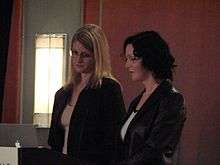Trans woman
A trans woman is a woman who was assigned male at birth. Trans women may experience gender dysphoria and may transition; this process commonly includes hormone replacement therapy and sometimes sex reassignment surgery, which can bring relief and resolve feelings of gender dysphoria. Trans women may be heterosexual, bisexual, homosexual, asexual, or identify with other terms (such as queer).
| Part of a series on |
| Transgender topics |
|---|
|
|
|
Health care and medicine |
|
Rights issues
|
|
Society and culture
|
|
By country
|
|
|
The term transgender woman is not always interchangeable with transsexual woman, although the terms are often used interchangeably. Transgender is an umbrella term that includes different types of gender variant people (including transsexual people). Trans women face significant discrimination in many areas of life (transmisogyny, a subset of transphobia), including in employment and access to housing, and face physical and sexual violence and hate crimes, including from partners; in the United States, discrimination is particularly severe towards trans women who are members of a racial minority, who often face the intersection of transphobia and racism.
Overview

Both transsexual and transgender women may experience gender dysphoria, distress brought upon by the discrepancy between their gender identity and the sex that was assigned to them at birth (and the associated gender role or primary and secondary sex characteristics).[1]
Both transsexual and transgender women may transition. A major component of medical transition for trans women is estrogen hormone replacement therapy, which causes the development of female secondary sex characteristics (breasts, redistribution of body fat, lower waist–hip ratio, etc.). This, along with sex reassignment surgery can relieve the person of gender dysphoria.[2][3]
Terminology
The term trans woman originates from the use of the Latin prefix trans- meaning "across, beyond, through, on the other side of,[4] to go beyond" and woman.[5] The term was first used in Leslie Feinberg's 1996 book Transgender Warriors: Making History from Joan of Arc to Dennis Rodman.[5] The book describes a trans woman as "a male-to-female transgender or transsexual person."[6] This definition is widely accepted and used in the Oxford English Dictionary. However, she elaborates on it by saying that being a trans woman often has a negative connotation.[6] She explains that people refer to trans women as "freaks" and that her gender expression has made her a "target."[6]
Heidi M. Levitt provides a simpler description of trans woman. She defines trans woman as "the sex of those who transition from one sex to the other."[7] Levitt mentions how the abbreviation "MTF" is commonly used, meaning male-to-female.[7] A final perspective by Rachel McKinnon explains how the term is complicated.[8] While some trans women have undergone surgery and may have female genitalia, many struggle in society to pass as a woman and be accepted.[8] This ability to pass can cause one who was considered a trans woman to be seen just as any other woman.[8] She explains that this is controversial since trans women do not have the biological ability to reproduce and are missing a uterus and ovaries.[8] However, she concludes that "trans women are women" who challenge socially constructed norms of what it means to be a woman.[8]
The CDC refers to the word "transgender" as "an umbrella term for persons whose gender identity or expression (masculine, feminine, other) is different from their sex (male, female) at birth".[9] Trans woman is commonly interchanged with other terms such as transgender woman and transsexual woman.[7] According to OxfordDictionaries.com, transgender means "denoting or relating to a person whose sense of personal identity and gender does not correspond with their birth sex."[10] However, Heidi M Levitt describes transgender as "different ways in which people transgress the gender boundaries that are constituted within a society."[7] She then describes how one must understand the difference between sex and gender in order to fully understand transgender.[7] She argues that sex is biological whereas "gender is a social construct."[7] Thus people who are transgender express themselves differently than their biological sex. In contrast, Levitt explains that "transsexual people have a sexual identity that does not match their physical sex" and that some desire sex-reassignment surgery.[7]
In addition, the Oxford English Dictionary refers to transsexual as "having physical characteristics of one sex and psychological characteristics of the other" and "one whose sex has been changed by surgery."[5] These definitions show that someone who is transsexual expresses their gender differently than assigned at birth. In addition, they may want or undergo surgery to change their physical appearance. Thus trans women fall under the umbrella of being transgender because their gender was assigned male at birth but they identify as a woman.[7] However, not all trans women are transsexual since they may or may not choose to undergo sex-reassignment surgery.[7]
Some trans women who feel that their gender transition is complete prefer to be called simply women, considering trans woman or male-to-female transsexual to be terms that should only be used for people who are not fully transitioned. Likewise, many may not want to be seen as a "trans woman," often owing to the societal otherization of trans individuals. Among those who do refer to themselves as trans women, many see it as an important and appropriate distinction to include a space in the term, as in trans woman, thus using trans as merely an adjective describing a particular type of woman; this is in contrast to the usage of transwoman as one word, implying a "third gender".[11]
Sexual orientation
Trans women may identify as heterosexual (or straight), bisexual, homosexual (or lesbian), asexual, or none of the above.[9][12][13][14] A survey of roughly 3000 American trans women showed 31% of them identifying as bisexual, 29% as "gay/lesbian/same-gender", 23% as heterosexual, 7% as asexual, as well as 7% identifying as "queer" and 2% as "other".[15] Some have argued that these identifications are not recognized by broader society, which can label trans people as gay, even if they are not.[16]
Libido
In a 2008 study, trans women had a higher incidence of low libido (34%) than cisgender women (23%), but the difference was not statistically significant and may have been due to chance.[17] As in males, female libido is thought to correlate with serum testosterone levels[18][19][20][21] (with some controversy[22]) but the 2008 study found no such correlation in trans women.[17][23] Another study, published in 2014, found that 62.4% of trans women reported their sexual desire had decreased after sexual reassignment therapy.[24]
Violence towards trans women
Trans women face a form of violence known as trans bashing. The Washington Blade reported that Global Rights, an international NGO, tracked the mistreatment of trans women in Brazil, including at the hands of the police.[25] To commemorate those who have been murdered in hate crimes, an annual Transgender Day of Remembrance is held in various locations across Europe, America, Australia, and New Zealand, with details and sources for each murder provided at their website.[26]
United States
According to a 2009 report by the National Coalition of Anti-Violence Programs, quoted by the Office for Victims of Crime, 11% of all hate crimes towards members of the LGBTQ community were directed towards trans women.[27]
In 2015 a false statistic was widely reported in the United States media stating that the life expectancy of a trans woman of color is only 35 years.[28] This appears to be based on a comment specifically about Latin America in a report by the Inter-American Commission on Human Rights, which compiled data on the age at death of murdered trans women for all of the Americas (North, South, and Central), and does not disaggregate by race.[28][29][30]
In 2016, 23 transgender people suffered fatal attacks in the United States. The Human Rights Campaign report found some of these deaths to be direct results of an anti-transgender bias, and some due to related factors such as homelessness.[31]
One type of violence towards trans women is committed by perpetrators who learn that their sexual partner is transgender and feel deceived. Almost 95% of these crimes were committed by cisgender men towards trans women.[32] According to a 2005 paper looking at HIV needs analysis in Houston, Texas, "50% of transgender people surveyed had been hit by a primary partner after coming out as transgender".[27]
Discrimination
Trans women, like all gender variant people, often face discrimination and transphobia.[15]:8 A 2014 survey from The Williams Institute found that, of 6,546 respondents (self-identified transgender, as well as gender nonconforming), 57% whose families had rejected them attempted suicide, as did 63–78% of those who suffered physical or sexual violence at school (any level).[33]
A survey of roughly 3000 trans women living in the United States, as summarized in the report "Injustice at Every Turn: A Report of the National Transgender Discrimination Survey", found that trans women reported that:[15]
- 36% have lost their job due to their gender.
- 55% have been discriminated against in hiring.
- 29% have been denied a promotion.
- 25% have been refused medical care.
- 60% of the trans women that have visited a homeless shelter reported incidents of harassment there.
- When displaying identity documents incongruent with their gender identity/expression, 33% have been harassed and 3% have been physically assaulted.
- 20% reported harassment by police, with 6% reporting physical assault and 3% reporting sexual assault by an officer. 25% have been treated generally with disrespect by police officers.
- Among jailed trans women, 40% have been harassed by inmates, 38% have been harassed by staff, 21% have been physically assaulted, and 20% have been sexually assaulted.
The American National Coalition of Anti-Violence Programs' report of 2010 anti-LGBTQ violence found that of the 27 people who were murdered because of their LGBTQ identity, 44% were trans women.[34]
Discrimination is particularly severe towards non-white trans women, who experience the intersection of racism and transphobia. For example, a potential result of such discrimination is that multiracial, Latina, black and indigenous American trans women are twice to more than three times as likely as white trans women to be sexually assaulted in prison.[35]
In her book Whipping Girl, trans woman Julia Serano refers to the unique discrimination trans women experience as "transmisogyny".[36]
Discrimination against trans women has occurred at the Michigan Womyn's Music Festival after the Festival set out a rule that it would only be a space for cisgender females. This led to protests by trans women and their allies, and a boycott of the Festival by Equality Michigan in 2014. The boycott was joined by the Human Rights Campaign ("HRC"), the Gay & Lesbian Alliance Against Defamation ("GLAAD"), the National Center for Lesbian Rights ("NCLR"), and the National LGBTQ Task Force ("The Task Force"). The "womyn-born-womyn" intention first came to attention in 1991 after a transsexual festival-goer, Nancy Burkholder, was asked to leave the festival when several women recognized her as a trans woman and expressed discomfort with her presence in the space.[37][38]
Notable trans women



- Marja-Sisko Aalto, Finnish former Evangelical-Lutheran priest
- Calpernia Addams, American actress, author, autobiographer, entrepreneur, activist, fiddle player
- Aderet, Israeli pop singer
- Rebecca Allison, American cardiologist and past President of the Gay and Lesbian Medical Association (GLMA)
- Nadia Almada, Portuguese-British Big Brother UK 2004 winner
- Barbra Amesbury, Canadian singer-songwriter
- Charlie Jane Anders, writer and co-editor of the blog io9
- Enza Anderson, Canadian media personality and political activist
- Erica Andrews aka Erica Salazar, Mexican-born American international and national beauty pageant title winner, drag performer, actor and entrepreneur
- Anna Anthropy, American video-game designer and critic
- Gwen Araujo, American teenage murder victim
- Patrícia Araújo, Brazilian actress and model
- Alexis Arquette, American actress, musician, member of the Arquette family of actors
- Nina Arsenault, Canadian writer, actress, columnist and sex-trade worker
- April Ashley, British model
- Estelle Asmodelle, Australian actress, author, dancer, and transgender activist
- Mianne Bagger, Danish-Australian professional golfer
- Jenny Bailey, British politician and mayor
- Christine Beatty, American writer, musician and transgender activist
- Danielle Bunten Berry, American computer programmer and game designer
- Georgina Beyer, New Zealand politician, first transgender person globally to become a mayor (1995) and a member of Parliament (1999)
- Alexandra Billings, American actress
- Maddie Blaustein, American voice actress
- Alejandra Bogue, Mexican actress and TV host
- Marci Bowers, American gynaecologist and sex-reassignment surgeon
- Wendy Carlos, American electronic music pioneer
- Carmen Carrera, American reality television personality, model, actress, and burlesque performer
- Candis Cayne, American actress and entertainer
- The Lady Chablis, American actress, drag performer and writer
- Parinya Charoenphol, Thai muay thai boxer, actress and model
- Jamie Clayton, American model and actress
- Roberta Close, Brazilian model
- Coccinelle, French actress, entertainer and transgender activist
- Canary Conn, American musician and author
- Raewyn Connell, Australian sociologist
- Joanne Conte, American politician and activist
- Lynn Conway, American computer scientist, electrical engineer and transgender activist
- Caroline Cossey (a.k.a. Tula), English model
- Jayne County, American rock singer
- Roberta Cowell, First legally recognized male to female transgender person in the UK (1951), memoirist
- Laverne Cox, American actress
- Katelynn Cusanelli, cast member on MTV's The Real World: Brooklyn, and the first transgender individual to star on the show.
- Florencia De La V, Argentine actress
- Michelle Duff, Canadian former Grand Prix motorcycle road racer
- Michelle Dumaresq, Canadian downhill mountain bike racer
- Lili Elbe, Danish artist, society figure and early recipient of sex reassignment surgery (1930)
- Eli Erlick, American trans activist
- Bülent Ersoy, Turkish singer of Ottoman classical music
- Bibiana Fernández, Spanish presenter and actress
- Ina Fried, American journalist and senior writer for CNET Networks
- Chiya Fujino, Japanese fiction author
- BB Gandanghari, Filipina actress and commercial model
- Francis García, Mexican performer and actress
- Gigi Gorgeous, Canadian YouTube personality, model, and actress
- Laura Jane Grace, lead singer and guitarist for punk rock band Against Me!
- Miss Major Griffin-Gracy, African-American activist[39]
- Anna Grodzka, Polish politician
- Harisu, South Korean entertainer, actress, and singer
- Choi Han-bit, South Korean model
- Ai Haruna, Japanese singer and television personality
- Lauren Harries, British media personality
- Rebecca Heineman, co-founder of Interplay; video game programmer
- Adela Hernandez, first transgender person elected to political office in Cuba[40]
- Rita Hester, African American murder victim
- Jenny Hiloudaki, Greek model
- Stephanie Hirst, British radio DJ
- Dana International, Israeli pop singer
- Kim Coco Iwamoto, American politician
- Juliet Jacques, British journalist
- Andrea James, American filmmaker and activist
- Caitlyn Jenner,[41] American Olympic athlete, reality television actress on Keeping Up with the Kardashians, stepparent to the Kardashian family
- Christine Jorgensen, first person to become widely known in the United States for having sex reassignment surgery (1953)
- Aya Kamikawa, Japanese politician
- Isis King, American designer and finalist on America's Next Top Model
- Victoria Kolakowski, American lawyer and judge
- Eden Lane, American broadcaster
- Loiza Lamers, Dutch model and winner of Holland's Next Top Model
- Jennifer Leitham, American double-bass musician
- Amanda Lepore, American model and performer.
- Dr Rachel Levine, American pediatrician, Pennsylvania state Physician General (2015-2017), Secretary of Health (2017-)
- Chen Lili, Chinese singer, model and actress
- Alicia Liu, Taiwanese model and television personality
- Ts Madison, pornographic actress, producer, director, recording artist, entrepreneur, and adult entertainment executive
- Kellie Maloney, British boxing manager and politician
- Rachel Mann, British Anglican priest and writer
- Chelsea Manning, United States Army soldier, convicted for leaking classified documents through WikiLeaks
- Deirdre McCloskey, American economist
- Janet Mock, American transgender activist and writer
- Micheline Montreuil, Canadian lawyer, teacher, writer, radio host, trade unionist and politician
- Jan Morris, British writer
- Ataru Nakamura, Japanese singer
- NikkieTutorials, Dutch makeup artist and Youtuber
- Judiel Nieva, Filipina alleged witness of a Marian apparition
- Bell Nuntita, Thai freelance singer, entertainer and radio D.J
- Dee Palmer, English musician (Jethro Tull)
- Andreja Pejić, Australian model
- Kim Petras, German singer
- Ashlee Marie Preston, American media personality, journalist and activist
- Veronique Renard, Dutch author and Free-Tibet activist
- Renée Richards, American tennis player
- Miriam Rivera, reality television, Mexican television personality and model
- Sylvia Rivera, American activist and founding member of the Gay Liberation Front, Gay Activists Alliance, and co-founder of Street Transvestite Action Revolutionaries; the Sylvia Rivera Law Project is named in her memory
- Martine Rothblatt, American lawyer, technological theorist, author and entrepreneur
- Joan Roughgarden, American biologist
- Carmen Rupe, New Zealand/Australian entertainer, politician, activist and cultural identity
- Jessica Amanda Salmonson, American fantasy author
- Kayo Satoh, Japanese model and television personality
- Julia Serano, American writer, trans activist, and biologist
- Vanessa Show, Argentine performer
- Amanda Simpson, Executive Director of the Army Energy Initiatives Task Force, United States Department of Defense
- Dana Simpson, American cartoonist (Ozy and Millie, Phoebe and Her Unicorn)
- Theresa Sparks, executive director of the San Francisco Human Rights Commission
- Allanah Starr, pornographic actress and party hostess
- Abby Stein, American trans activist, writer, speaker, and educator.
- Sandy Stone, American academic theorist, media theorist, author, and performance artist
- Margaret Stumpp, American executive
- Lea T, Brazilian fashion model
- Audrey Tang, Taiwanese free software programmer
- Manuela Trasobares, Spanish artist, opera singer and politician
- Ayana Tsubaki, Japanese television personality and fashion model
- Daniela Vega, Chilean film actress
- Lana and Lilly Wachowski, American film directors, screenwriters, and producers (The Matrix)
- Bali White, researcher and activist
- Sophie Wilson, British computer scientist
- Narcissa Wright, American speedrunner
- Jin Xing, Chinese ballerina, modern dancer, choreographer, and actress
- Marie-Pier Ysser, French entertainer and academic
See also
- Trans man
- Transfeminism
- List of transgender-related topics
References
- "Standards of Care for the Health of Transsexual, Transgender, and Gender Nonconforming People (version 7)" (PDF). The World Professional Association for Transgender Health. p. 96. Archived from the original (PDF) on 2014-09-24.
- Beidel, Deborah C; Frueh, B. Christopher; Hersen, Michel (30 June 2014). Adult Psychopathology and Diagnosis (7th ed.). New York: [[Wiley]]. p. 618. ISBN 978-1-118-92791-5. OCLC 956674391. Retrieved 12 December 2017.CS1 maint: extra punctuation (link)
- Köllen, Thomas (25 April 2016). Sexual Orientation and Transgender Issues in Organizations: Global Perspectives on LGBT Workforce Diversity. Springer. p. 138. ISBN 978-3-319-29623-4. OCLC 933722553. Retrieved 12 December 2017.
- Hoogland, Renée C. (2016). Gender: Sources, Perspectives, and Methodologies. Macmillan Reference USA, a part of Gale, Cengage Learning. pp. 377–392. ISBN 978-0-02-866282-4.
- "Oxford English Dictionary".
- Feinberg, Leslie. Transgender Warriors: Making History from Joan of Arc to Dennis Rodman. Boston, MA: Beacon, 2005. 1996. Web. 23 Apr. 2017.
- Levitt, Heidi M. "Transgender." International Encyclopedia of the Social Sciences, edited by William A. Darity, Jr., 2nd ed., vol. 8, Macmillan Reference USA, 2008, pp. 431-432. Gale Virtual Reference Library. Web. 3 Apr. 2017
- McKinnon, Rachel. "Gender, Identity, and Society." Philosophy: Sex and Love, edited by James Petrik and Arthur Zucker, Macmillan Reference USA, 2016, pp. 175-198. Macmillan Interdisciplinary Handbooks. Gale Virtual Reference Library. Web. 23 Apr. 2017.
- "Lesbian, Gay, Bisexual and Transgender Health". Centers for Disease Control and Prevention. 18 May 2017. Retrieved 27 July 2018.
- "transgender | Definition of transgender in English by Oxford Dictionaries". Oxford Dictionaries | English. Retrieved 2018-07-20.
- Serano, Julia (2007). Whipping girl: a transsexual woman on sexism and the scapegoating of femininity. Emeryville, California: Seal Press. pp. 29–30. ISBN 978-1-58005-154-5.
- "Transgender FAQ". GLAAD. 2020. Archived from the original on April 7, 2020. Retrieved June 30, 2020.
- Cooper, Christopher (June 26, 2017). "My Experiences As A Straight Cis Man Engaged To A Straight Trans Woman". HuffPost. Archived from the original on June 30, 2020. Retrieved June 30, 2020.
- Bogert, Brennan (September 10, 2018). "11 Dating Struggles Only Trans Lesbians Will Understand". GoMag. Archived from the original on June 30, 2020. Retrieved June 30, 2020.
- "Injustice at Every Turn: A Report of the National Transgender Discrimination Survey" (PDF). National Center for Transgender Equality & National Gay and Lesbian Task Force. 2015-01-21. p. 29.
- Herman, Joanne (June 30, 2011). "Some Transgender People Are Not Gay". HuffPost. Archived from the original on June 30, 2020. Retrieved June 30, 2020.
- Elaut E, De Cuypere G, De Sutter P, Gijs L, Van Trotsenburg M, Heylens G, Kaufman JM, Rubens R, T'Sjoen G (Mar 2008). "Hypoactive sexual desire in transsexual women: prevalence and association with testosterone levels". European Journal of Endocrinology. 158 (3): 393–9. doi:10.1530/EJE-07-0511. PMID 18299474.
- Turna B, Apaydin E, Semerci B, Altay B, Cikili N, Nazli O (2005). "Women with low libido: correlation of decreased androgen levels with female sexual function index". International Journal of Impotence Research. 17 (2): 148–153. doi:10.1038/sj.ijir.3901294. PMID 15592425.
- Santoro N, Torrens J, Crawford S, Allsworth JE, Finkelstein JS, Gold EB, Korenman S, Lasley WL, Luborsky JL, McConnell D, Sowers MF, Weiss G (2005). "Correlates of circulating androgens in mid-life women: the Study of Women's Health Across the Nation". Journal of Clinical Endocrinology and Metabolism. 90 (8): 4836–4845. doi:10.1210/jc.2004-2063. PMID 15840738.
- Sherwin BB, Gelfand MM, Brender W (1985). "Androgen enhances sexual motivation in females: a prospective, crossover study of sex steroid administration in the surgical menopause". Psychosomatic Medicine. 47 (4): 339–351. doi:10.1097/00006842-198507000-00004. PMID 4023162.
- Sherwin, B (1985). "Changes in sexual behavior as a function of plasma sex steroid levels in post-menopausal women". Maturitas. 7 (3): 225–233. doi:10.1016/0378-5122(85)90044-1. PMID 4079822.
- Davis SR, Davison SL, Donath S, Bell RJ (2005). "Circulating androgen levels and self-reported sexual function in women". Journal of the American Medical Association. 294 (1): 91–96. doi:10.1001/jama.294.1.91. PMID 15998895.
- DeCuypere G, T'Sjoen G, Beerten R, Selvaggi G, DeSutter P, Hoebeke P, Monstrey S, Vansteenwegen A, Rubens R (2005). "Sexual and physical health after sex reassignment surgery". Archives of Sexual Behavior. 34 (6): 679–690. doi:10.1007/s10508-005-7926-5. PMID 16362252.
- Wierckx, Katrien; Elaut, Els; Van Hoorde, Birgit; Heylens, Gunter; De Cuypere, Griet; Monstrey, Stan; Weyers, Steven; Hoebeke, Piet; t'Sjoen, Guy (2014). "Sexual Desire in Trans Persons: Associations with Sex Reassignment Treatment". The Journal of Sexual Medicine. 11 (1): 107–118. doi:10.1111/jsm.12365. PMID 24165564.
- Lavers, Michael K. (25 November 2013). "Report documents anti-transgender violence, discrimination in Brazil". Washington Blade: Gay News, Politics, LGBT Rights. Retrieved 11 April 2018.
- "Transgender Day of Remembrance". Transgender Day of Remembrance.
- "Sexual Assault: The Numbers – Responding to Transgender Victims of Sexual Assault". Office for Victims of Crime. Retrieved 25 April 2018.
- Herzog, Katie. "Is the Life Expectancy of Trans Women in the U.S. Just 35? No". The Stranger.
- Inter-American Commission on Human Rights. "IACHR: Forms and contexts of violence against LGBTI persons in the Americas". IACHR: Inter-American Commission on Human Rights. Retrieved 11 April 2018.
- Lavers, Michael K. (20 December 2014). "Nearly 600 LGBT people murdered in Americas in 15 months". Washington Blade: Gay News, Politics, LGBT Rights. Retrieved 11 April 2018.
- "Violence Against the Transgender Community in 2017 | Human Rights Campaign". Human Rights Campaign. Retrieved 11 April 2018.
- SCHILT, KRISTEN; WESTBROOK, LAUREL (2009). "DOING GENDER, DOING HETERONORMATIVITY: "Gender Normals," Transgender People, and the Social Maintenance of Heterosexuality". Gender and Society. 23 (4): 440–464. doi:10.1177/0891243209340034. ISSN 0891-2432. JSTOR 20676798.
- Haas, Ann; Rodgers, Philip; Herman, Jody. "Suicide Attempts among Transgender and Gender Non-Conforming Adults" (PDF). Retrieved 2016-12-10.
- "70 Percent of Anti-LGBT Murder Victims Are People of Color".
- "NTDS Report" (PDF).
- Barker-Plummer, Bernadette (2013). "Fixing Gwen". Feminist Media Studies. 13 (4): 710–724. doi:10.1080/14680777.2012.679289.
- Williams, Cristan (April 9, 2013). "Michigan Womyn's Music Festival". The TransAdvocate.
- "Myths and The Truth About the Michigan Womyn's Music Festival". thetruthaboutthemichiganfestival.com. September 2014.
- Stryker, Susan (2008). Transgender history. Berkeley, CA: Seal Press. p. 56. ISBN 978-0-7867-4136-6.
- "Transgender Woman 1st to Win Office in Cuba". ABC News, November 16, 2012.
- "Bruce Jenner: 'I'm a Woman'". ABC News. 2015-04-27. Retrieved 26 April 2015.